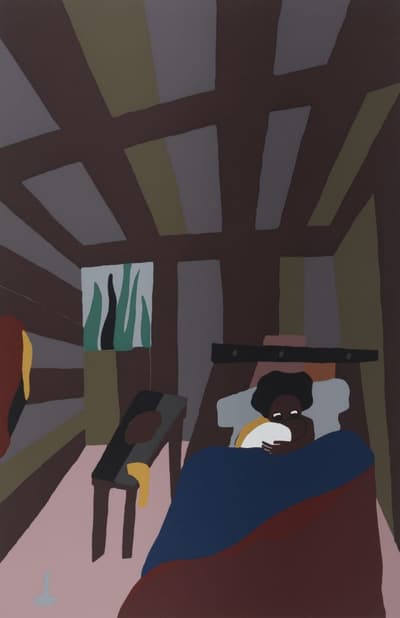

The Life of Toussaint L’Ouverture, a rare series of 15 prints by Jacob Lawrence, manifests the artist’s remarkable ability to poignantly chronicle little-known histories. Haiti was the first republic in the world to be founded by former slaves. An important fact on its own terms, this history and Toussaint L'Ouverture’s role in this quest for freedom gains a new level of relevance today within the context of the ongoing struggle for racial justice.
The artist’s strong angular figuration and bold use of color expressively depict L'Ouverture’s struggle against slavery and oppression. Born into slavery in 1743, L'Ouverture was an early participant in the rebellion, eventually rising to become commander in chief of the revolutionary army and leading the campaign in 1800 to draft Haiti’s first democratic constitution. L'Ouverture was arrested by Napoleon Bonaparte’s troops in 1802 and sent to Paris, where he was imprisoned and died a year later, shortly before Haiti became a republic in 1804.






Lawrence’s graphic acumen is on full display in depicting the lockstep advance of L'Ouverture’s army. When he transferred the paintings into print many of his revisions consisted of minor modifications to the palette or adjustments in compositional emphasis. Here he sets the scene against a much lighter sky. Silkscreen’s broad, flat colors emphasize the unity of the revolutionary forces, but Lawrence distinguishes certain figures by adding white contour lines to their profiles. In the printed version, he also introduces red to the foliage, creating a chromatic rhyme with the soldiers’ uniforms and alluding, perhaps, to the blood already shed in these fields under slavery and the conflicts yet to come.




L'Ouverture, as Lawrence depicts him, was a man of thought and action alike. All too aware of the necessity of literacy as a tool for political self-expression and negotiation, he dedicated himself to the study of French, his third language after West African Fon and Haitian Kreyòl (Creole). He amassed a library of volumes devoted to statecraft and political history. Contemplation also foreshadows L'Ouverture’s later authorship of a work often called a memoir but intended as a 16,000-word petition for a public trial. He wrote this document while in prison after his 1802 capture by a French general acting under orders from Napoleon Bonaparte.




